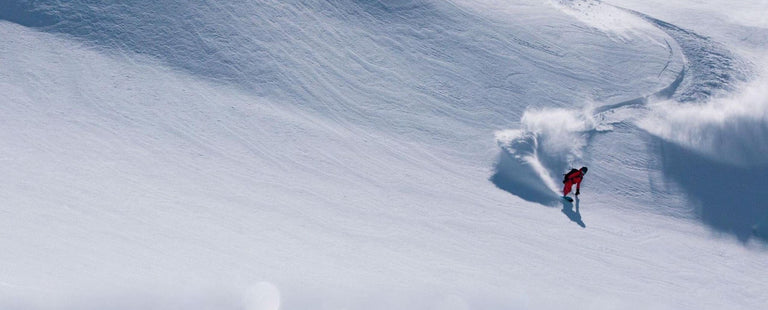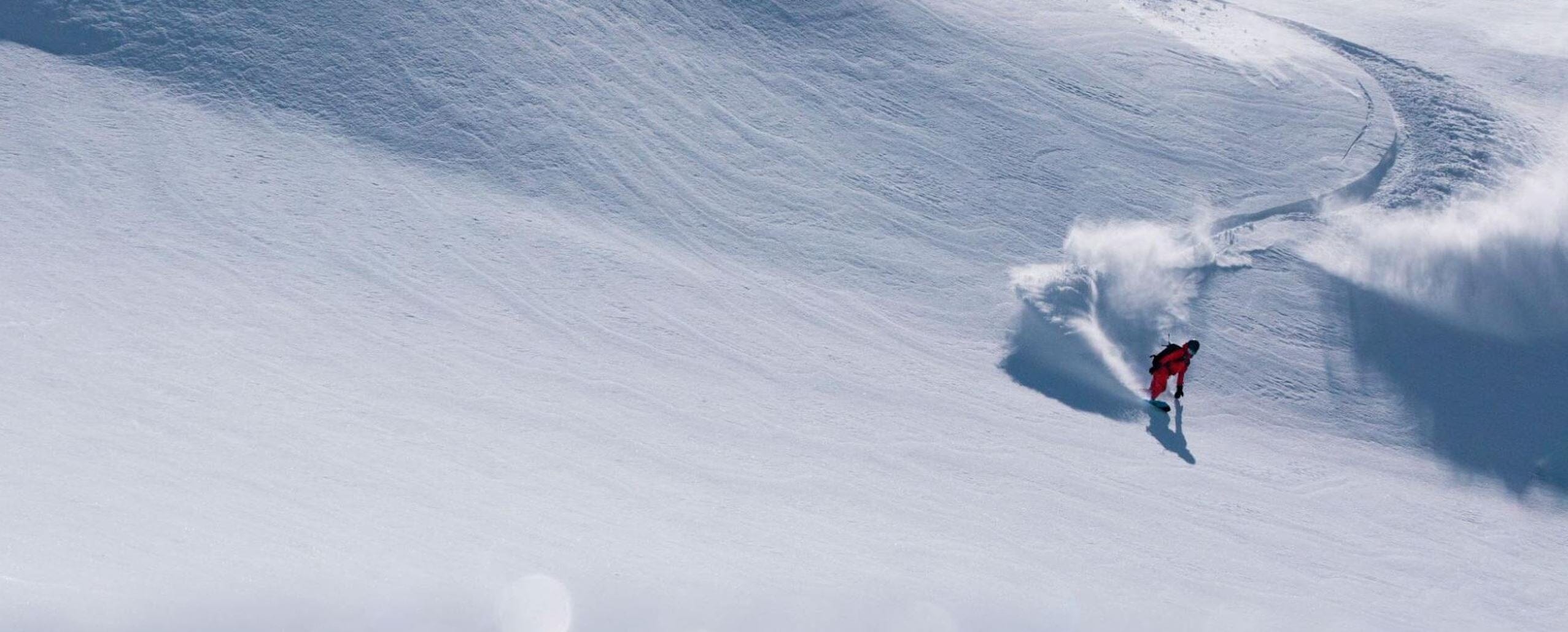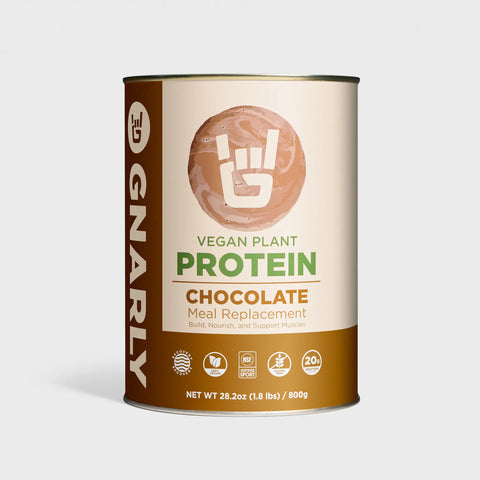The backcountry holds a huge amount of intrigue for many people, and for good reason: no lift lines, immersion in nature, pushing physical and mental boundaries - and possibly most alluring - untracked pow for days. But before you pack up the car and start making your way to a trailhead, it’s crucial to make sure you have the right gear to make for a positive experience and keep you safe out there.
Now, the topic of backcountry gear can get pretty lengthy and there is a plethora of great information across the interwebs all about the many different brands, products, and more that you can choose from. We will resist the urge to recommend any particular brand or product here, and instead focus on the basics behind each item. While you may still have questions after this article, there are countless places online where you can dive deeper into any one item and get all the info you need. We also suggest making a visit to your local, trusted shop where they can help you get dialed in + answer any questions you might have. Remember: everyone will have opinions on what item is the best, based on their own experiences, but your goal will be to figure out what will work best for you.
* Before you embark on any tour into the backcountry, you should have the proper education, have a plan for the day, knowledge of the area + route you plan to take, and a trusted partner by your side. To help you out, here are some tips for getting into backcountry skiing and splitboarding.

Avalanche safety gear
- Probe: a probe is, well, just as it sounds: a long stick-like item that you will use to probe through the snow in the case of an avalanche burial. Probes come in many different lengths, and the #1 consideration for you when buying one is to make sure you get one that is long enough.
- Shovel: your shovel will be your way of digging out anyone who may be buried in an avalanche. And no, we don’t mean just any shovel from your shed. You should have a designed avalanche/snow shovel, typically one that can break down into two pieces and be packed well in your backpack.
- Transceiver: also known as a beacon, this will be one of the pricier investments that you make - but don’t even think about skipping it. Your transceiver will be your lifeline in the case that you are buried under snow, and will also be your main tool in locating + saving anyone else who could be buried. When purchasing a beacon, be sure to get something boasting modern technology (3-antenna is highly recommended) and in good working condition.
Your shovel and beacon will be stored in your pack, but your transceiver will be stored on your body. Most people will either use the harness that comes with the transceiver to wear it on your abdomen, or use a designated pocket on their pants/bibs to store (and secure) their transceiver.
* While it’s important to be familiar with all of your gear, it is imperative to be well-versed and practiced with your transceiver, probe, and shovel. Both through formal education, training, and practicing on your own in regular intervals, the last thing you want is to be in a burial situation and not know how to use your gear properly.

“Beacon/Shovel/Probe are the north star. And we all want to prioritize a lighter pack, but do you have the adequate supplies you need if you end up spending a night in the backcountry or exit the backcountry in the dark?” - Erica Aarons, TREW Ambassador
Backpack
This list gets long, and many of the items below need a place to go while you’re hiking up + riding down. Your backpack should be sturdy and large enough to hold everything you need inside of the pack; in general, it’s not a good idea to have things hanging off of your pack unless the pack is designed specifically with that feature.
There are specialized ski/backcountry packs that have designated compartments for you shovel and probe, which are great for organization and fast & easy deployment in the case that you need to get to them quickly. Airbags: if you have the cash to spare and feel that you are going to venture into terrain + snowpack that warrants an airbag backpack, feel free to splurge. Just be sure you train with the pack and are completely familiar with how it works before heading out.
Skis or splitboard with proper touring bindings
Your choices on skis/boards and bindings these days are a bit daunting, but usually finding something that you trust and fits within your budget is a great way to start.
On skis, you don’t necessarily need a touring/backcountry ski - although some variation can be a nice investment for saving weight and having more fun on the uphill. Similar to selecting skis or a board for traditional resort riding, focus more on finding the right length, width, and profile (shape, stiffness, camber, rocker, etc.) for you - and if you can find these traits in a ski that is lighter, then it’s a win win!
When you are just getting started, you may opt to snowshoe uphill + carry your skis/board on your back. This is completely alright, although be aware that this will be a fair amount harder and less efficient than having a proper touring setup. 
Touring boots
Your main concern here is to make sure that you have a pair of boots that are compatible with your touring bindings. You will see many options for lightweight, touring boots on the market but you don’t need to have the latest and greatest so long as they work.
And, much like skiing or boarding at the resort, having the right pair of boots for you - that fit well, are comfortable, and are stiff/soft enough for you - is going to be a game changer, especially when you’re hiking uphill in them.
* This item is more important for backcountry skiers, as many splitboarders will use the same boots they would normally wear with a normal snowboard.
Climbing skins
If you’ve ever seen someone skiing uphill and have wondered, “how are they doing that??” then this is your answer. Climbing skins will stick to the bottom of your skis or board, and will keep you from sliding backwards when hiking uphill. There’s plenty of options out there, and it’s easy to get overwhelmed by the choices available, but assuming you find a pair in new or very good condition then you should be set up for success. The hardest part will be getting comfortable with walking uphill, but that will come with time!

“Start small, learn how to use your skins in a mellow, environment that's not too steep ;) And stand up straight and leave your weight on your heels when you're going up a slippery skin track, even though it's counterintuitive!” - Izzy Zaik, TREW Ambassador
Poles
Everyone going uphill will want a good set of poles - and yes that means you, too, splitboarders.
If you’re a skier, you can stick with your normal poles if you would like. But there are some benefits to a lightweight, retractable pole - and those longer hand grips are ince for when you’re hiking on off-camber terrain.
Splitboarders, go with a retractable pole, so that you can stow those things away once you turn downhill.
Sunglasses
It can be bright out there, and having some proper eye protection will make a big difference in the long run. If you are venturing out onto glaciers, having a pair of glacier glasses (with the wraparound protection) will be very helpful in protecting your eyes.
Goggles
These can be the very same goggles you use for resort riding. Just be prepared with the right lens for the conditions, and if your goggles allow you to swap lenses then bring some extra in case the weather turns.
Helmet
Sure, it’s not mandatory - but we’re firm believers that a helmet is the way to go. No need to wear it on the uphill, but as soon as you start pointing your board(s) downhill make sure to buckle it up.
Map + Compass
In addition to having a clear idea of where you’re going and a plan set before you even leave the car, having a map and a compass is never a bad idea. This goes triple if you know that you’re leaving cell phone service behind and won’t have access to your apps.

Clothing
- Shell jacket + bib/pant: don’t feel like you need to go out and buy completely new outerwear right away, but there are some big benefits to having a jacket and bib/pant that is designed specifically for the backcountry. This includes: great waterproofing, breathability, key ventilation, thoughtful storage, designated transceiver pocket, and more, cuff/kick patch reinforcement, and comfort/stretch in movement.
- Insulating layer (or two): this includes a down or synthetic insulated layer that packs well, possibly some fleece, and anything else that you may want in case the temps take a drop.
- Base layers: you will want something that will wick sweat away and keep you dry + warm, like merino wool or some sort of synthetic blend. A good pair of base layers will ensure that you don’t get cold after you stop moving at the top, after sweating all the way up.
- Extra layers: if you have room, an extra layer or two can be great to bring. You never know what might happen with the weather, and being prepared for anything never hurts.
- Light liner gloves/touring gloves: a light pair of gloves that you can wear when hiking uphill.
- Warm gloves: these can be the same that you wear in the resort, and the pair that you wear when you aren’t hiking up. A backup pair can be a good idea, as well.
- Winter hat: something warm to cover the head and ears is nice, especially when you take a snack break at the top before starting your descent.
- Sun hat: similar to having sunglasses, it can get bright out there and it’s a good idea to have proper protection from the sun (and elements in general)
- A buff (or two): these come in handy for a number of uses - providing warmth when needed, protection from the sun (if SPF rated) or the elements, and also acting as a good sweatband around your head when things get hot hiking up.
On the topic of clothing, we happen to make awesome backcountry-specific outerwear, base layers, and accessories that will check all of the boxes. Shop the TREW Backcountry Collection here!
Food & Water
Keeping your body fueled and hydrated throughout the day is crucial, both for your performance but also for your general happiness throughout….and since we’re all out there to enjoy ourselves and have fun, it’s a great idea to keep your body and mind in good condition.
First tip: pack more food and water than you think you will need. Second tip: bring a selection of snacks so that, no matter what you’re craving or how you are feeling, there will be something in your pack that you will want to eat. Chocolate, gummy bears, and a mini charcuterie board are all personal favorites from the TREW team.
“You can never have too many snacks or jackets.” - Ginny White, TREW Ambassador

We won’t get too into the weeds on the nutritional aspects, or how you can boost your performance with proper preparation and recovery fueling here; but if you do want to learn more about how to set yourself up for the greatest success, check out this great article on Fueling Winter Activities or Gnarly’s long list of recipes to make your own nutritious snacks for the skintrack.
Emergency Items
- Headlamp: you may not anticipate being out in the dark, but a solid headlamp should always be in your pack just in case.
- Extra batteries: Just a ziploc bag with some extra batteries that work with your transceiver and your headlamp, just in case something dies while you’re out.
- First aid kit: no need to bring your entire medicine cabinet, but a small first aid kit is great to have.
- Radio or satellite radio: it’s more and more common for folks to bring some sort of radio system with them, and it’s not a bad idea - especially if you’re heading out into remote regions where cell service can’t be relied upon.
- Emergency bivy: these pack down really small, take up very little room and space, and can be a lifesaver.
- Leatherman/multitool: if you don’t have one, you’ll probably wish you did. So just have one with you all the time.
- Spare parts for bindings/boots, etc.
- Sunscreen: not necessarily an emergency item, but this should always be in your pack.
- Duck tape: always good to have. Always!
And finally, a hot tip on gearing up.
The gear laid out above can get pricey. If you have the means, then go right for it….but for many of us, cutting some costs and saving some cash along the way can be a huge help. Here are some tips for saving some money as you get started:
- Buy used! For many of the items listed in this article, you can find great deals on lightly used items - either from online markets (FB Marketplace, craigslist, etc.) or from outdoor consignment shops, which are becoming more and more popular. We would recommend being very cautious when buying used on avalanche safety items, and to ensure that the item(s) are in excellent condition before purchasing. It never hurts to splurge on a transceiver and get it new, just to know that you can trust it with your life.
- Rent first! There are so many shops nowadays that let you rent backcountry gear - from the skis/bindings/boots all the way to the full avalanche safety kit - and this is an excellent way to give it a try before you go full in on your own gear. Some places even allow you to rent for a weekend, or for a week at a time, so you can take the gear out and really try it out.
- Demo, demo, demo! When choosing skis or boards and bindings, try to find a way to demo them before you buy. You can either demo from a shop for a low price (and oftentimes have that price go towards a purchase later on) or find a demo event at a mountain where you can try multiple setups in a day for free!
“You don't need the newest, most expensive gear. Buy used and it makes the financial barrier way easier to overcome to get into backcountry snowboarding. You also don't need the lightest gear either. Everyone will learn at their own pace and once you are experienced enough to know what you want you can upgrade your gear.” - Brian Stenerson, TREW Ambassador

This article was written by TREW Gear, a backcountry-focused outerwear company based in Portland, OR. TREW believes that people who have positive experiences in the mountains are better stewards for the environment, happier people in their communities, and more motivated to make the world a better place. Thus, they spend all of their time working to make the best gear to keep the good times rolling - for everyone!
TREW Gear and Gnarly Nutrition are teaming up to make this your best season yet! To celebrate this partnership, use the code TREWLYGNARLY to get 20% off select outerwear from TREW Gear AND 20% off your next order with Gnarly!
#stayTREW #PushYourPossible
Images by Zoya Lynch.




